NIOSH Guide to the Selection and Use of Particulate Respirators
January 1996
DHHS (NIOSH) Publication Number 96-101
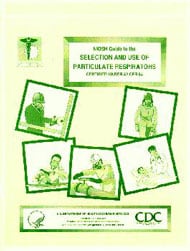
Certified Under 42 CFR 84
Disclaimer: Mention of any company name or product does not constitute endorsement by the National Institute for Occupational Safety and Health
Appendices
Appendix A: Part 11 and Part 84 Labels for Various Filters
Part 11 Label for HEPA Filter
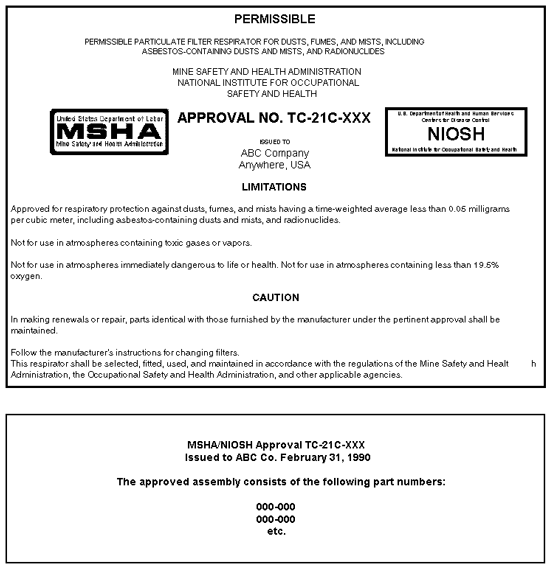
Part 84 Label for N100 and P95 Filter
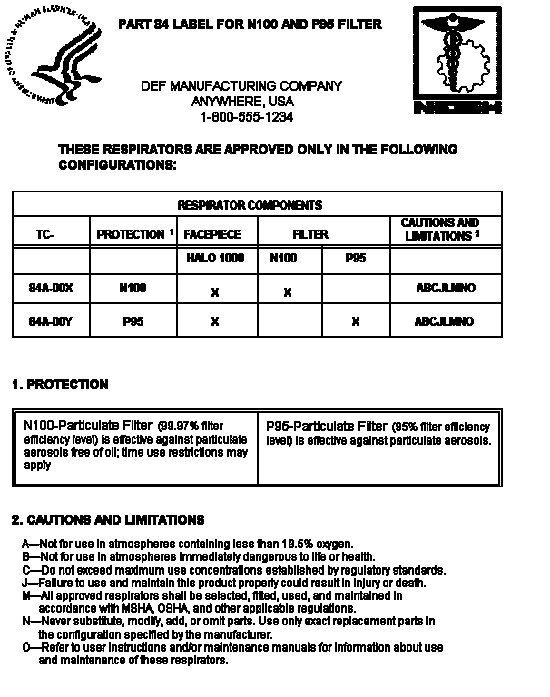
Part 84 Label for P100 Filter
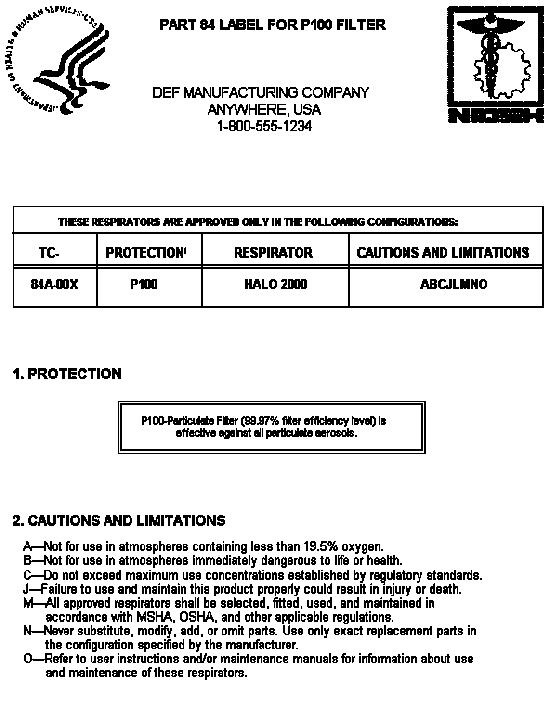
Appendix B: Substitution of Part 84 Respirators for Part 11 Respirators Already In Use
The following selection guidelines are intended for those who are currently using a Part 11 respirator that has been properly selected. In this context, a properly selected respirator means one that has been selected based on knowledge of the contaminant and its concentration in a particular work setting, the exposure limit of the contaminant, and the general principles of respirator selection.
Following these recommendations is the simplest approach to making the transition from Part 11 filters to Part 84 filters. However, this approach may yield filter recommendations that exceed those actually required in a particular work setting. For example, because both the 99% and 95% filters outperform the DM and DFM filter classes, there may be situations where the 99% or 95% filters are an appropriate substitute for a HEPA filter.
- If you are currently using a DFM or DM filter:
- In a work setting free of oil aerosols, the minimally protective filter would be an N95.
- In a work setting that may contain or does contain oil aerosols, the minimally protective filter would be an R95 or P95.
- If you are currently using a HEPA filter:
- In a work setting free of oil aerosols, an N100 filter would be protective.
- In a work setting that contains or may contain oil aerosols, an R100 or P100 filter would be protective.
Note: All nine classes of Part 84 filters are appropriate for protection against TB (see Chapter II, Section F).
- If you are currently using a paint-lacquer-enamel combination cartridge:
- In a work setting free of oil aerosols, a combination respirator consisting of an organic vapor cartridge and an N95 particulate filter with an optional prefilter (to prevent rapid clogging by paint aerosols) would be minimally protective.
- In a work setting that may contain or does contain oil aerosols, a combination respirator consisting of an organic vapor cartridge and an R95 or P95 particulate filter with a prefilter (to prevent rapid clogging by paint aerosols) would be minimally protective.
- If you are currently using a pesticide respirator for protection against a particulate and an organic vapor:
- A combination respirator consisting of an organic vapor cartridge and an N95 (non-oil aerosols) or an R95 or P95 particulate filter would be minimally protective.
- As another example, a particular pesticide may have such low vapor pressure that only a particulate filter may be needed. Thus in certain situations, there may be no need for a combination particulate filter and organic vapor cartridge as recommended above.
Note: Particulate filters will not protect against gases or vapors.
Appendix C: Flow Chart for Selecting Part 84 Particulate Filters
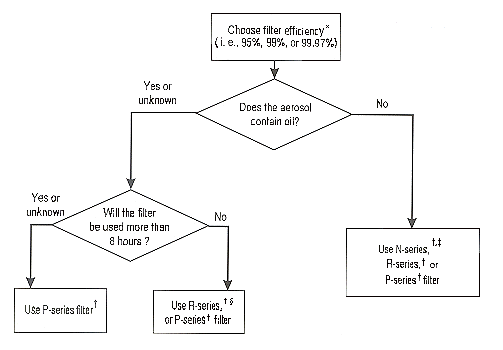
* The higher the filter efficiency, the lower the filter leakage.
† Limited by considerations of hygiene, damage, and breathing resistance.
‡ High (200 mg) filter loading in the certification test is intended to address the potential for filter efficiency degradation by solid or water-based (e.g., non-oil) aerosols in the workplace. Accordingly, there is n o recommended service time in most workplace settings. However, in dirty workplaces (high aerosol concentrations), service time should only be extended beyond 8 hours of use (continuous or intermittent) by performing an evaluation in specific workplace settings that demonstrates (a) that extended use will not degrade the filter efficiency below the certified efficiency level, or (b) that the total mass loading of the filter is less than 200 mg (100 mg per filter for dual filter respirators).
§ No specific service time limit when oil aerosols are not present. In the presence of oil aerosols, service time may be extended beyond 8 hours of use (continuous or intermittent) by demonstrating (a) that extended use will not degrade the filter efficiency below the certified efficiency level, or (b) that the total mass loading of the filter is less than 200 mg (100 mg per filter for dual-filter respirators).
Appendix D: Examples of Part 84 Respirator Selection
Respirator Selection Process for Iron Oxide Fume (25 mg/m3)
- The IDLH for iron oxide is 2,500 mg/m3 and there is sufficient oxygen so that an air-purifying respirator can be used.
- Iron oxide is not an oil particulate. Therefore, a respirator with a Type N filter can be used.
- The OSHA PEL for iron oxide is 10 mg/m3. The HR for iron oxide in this example is (25 mg/m3)/(10 mg/m3) = 2.5.
- A minimally appropriate respirator would be a half-mask respirator (commonly accepted APF = 10) with an N95 filter. The N95 filter service time is limited only by considerations of hygiene, damage, and breathing resistance.
Respirator Selection Process for Mixture of Copper Dust (22 mg/m3) and Oil Mist (8 mg/m3)
- The atmosphere is non-IDLH (2,500 mg/m3 for oil mist and 100 mg/m3 for copper) and has sufficient oxygen so that an air-purifying respirator can be used.
- The OSHA PEL is 1 mg/m3 for copper dust and 5 mg/m3 for oil mist.
- Oil mist is present; therefore, either an R- or P-series filter should be used.
- In this example, the HR for copper dust is (22 mg/m3)/(1 mg/m3) = 22, and the HR for the oil mist is (8 mg/m3)/(5 mg/m3) = 1.6. Since the copper dust HR is the higher of the two contaminants, this value should be used to select the appropriate respirator. Because the HR of 22 exceeds the APF of 10 for a half-mask respirator, a minimally appropriate respirator would be a full-facepiece respirator with either an R95 or a P95 filter. If the R95 filter is used, it should be used for one shift only (see Table 1 in Section C) unless the testing previously described has been done to allow more than one shift.
Respirator Selection Process for the Insecticide Dust Dinitro-o-Cresol (0.6 mg/m3)
- The IDLH for dinitro-o-cresol is 5 mg/m3 and there is sufficient oxygen so that an air-purifying respirator can be used.
- Dinitro-o-cresol is a solid particulate with a low vapor pressure, and there is no oil aerosol in this example. Therefore, a respirator with an N-series filter can be used (Note: See discussion on vapor in item 4, below).
- The OSHA PEL for dinitro-o-cresol is 0.2 mg/m3. The HR in this example for dinitro-o-cresol is (0.6 mg/m3)/(0.2 mg/m3) = 3.
- A minimally appropriate respirator would be a half-mask respirator (APF = 10) with an N95 filter. The N95 filter service time is limited by hygiene, damage, and breathing resistance. If a particular pesticide (including insecticide) presents a vapor hazard, a combination organic vapor and appropriate particulate filter should be used.
Appendix E: Commonly Asked Questions and Answers About Part 84 Respirators
- How effective are the Part 84 filter respirators against particles smaller than 0.3 micrometer in diameter?The 0.3-micrometer diameter used in the certification testing is approximately the most penetrating particle size for particulate filters. Although it seems contrary to expectation, smaller particles do not penetrate as readily as 0.3-micrometer particles. Therefore, these respirators will filter all other particle sizes at least as well as the certified efficiency level.
- How effective are the Part 84 filter respirators against asbestos fibers or other rod-shaped particles?Although fibers or rod-shaped particles may have very small cross-sectional diameters relative to their lengths, the Part 84 particulate filter respirators will be at least as efficient against this particle shape as the certified efficiency level.
- How do I tell a new Part 84 particulate filter from the Part 11 predecessors?There are several labeling changes for Part 84 filter respirators that should enable users to distinguish between the Part 11 and Part 84 respirators. These are as follows:
- NIOSH and DHHS emblems on Part 84 labels replace NIOSH and MSHA logos on Part 11 labels.
- The approval number will be in the format of TC-84A-xxxx for Part 84 devices rather than TC-21C-xxxx or TC-23C-xxxx for Part 11 devices (except for particulate PAPRs, which will continue to be numbered with the sequence TC-21C-xxxx or TC-23C-xxxx).
- The certification filter series and efficiency levels (e.g., N95, P100, etc.) are included on the Part 84 filter approval label.
- How long can I use my particulate respirator for TB exposures before I discard it?In the health care setting, the filter material used in respirators may remain functional for weeks to months [CDC 1994]. As long as there is no oil mist, reuse is limited only by considerations of hygiene, damage, and breathing resistance. Respirators with replaceable filters are designed for reuse, and a respirator classified as disposable may be reused by the same health care worker as long as it remains functional.Before each use, the filter material should be inspected. If the filter material is physically damaged or soiled, the filter should be changed (in the case of respirators with replaceable filters) or the respirator should be discarded (in the case of disposable respirators). Your employer should develop standard operating procedures for storing, reusing, and disposing of respirators designated as disposable and for disposing of replaceable filters.
- Is it always necessary to fit-check a respirator before each use?Fit-checking your respirator before each use is important to minimize contaminant leakage into the facepiece. Your respirator manufacturer has recommended fit-checking procedures that should be followed by the user each time the respirator is worn.
